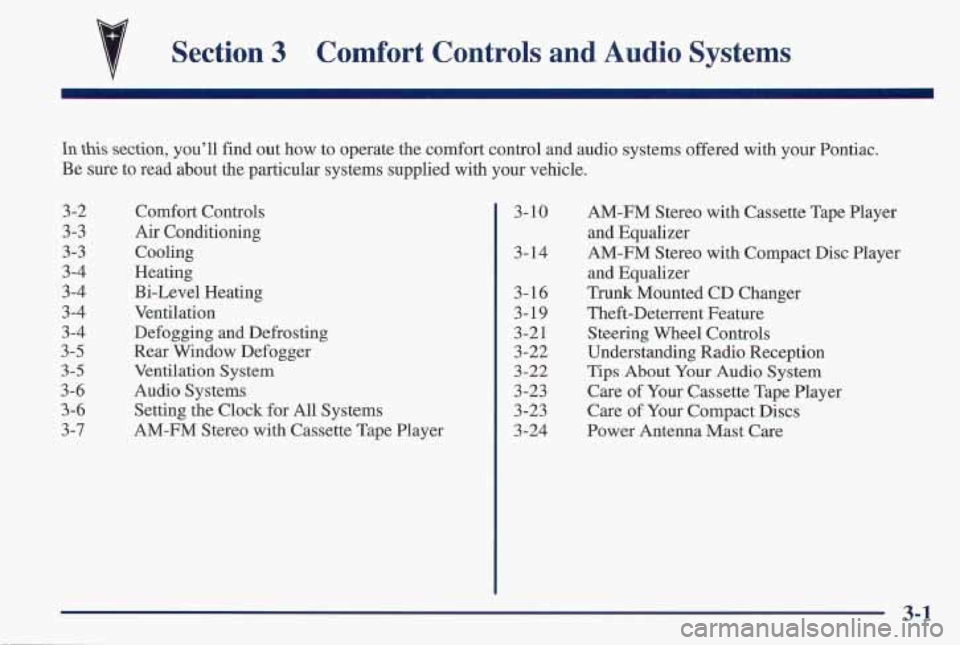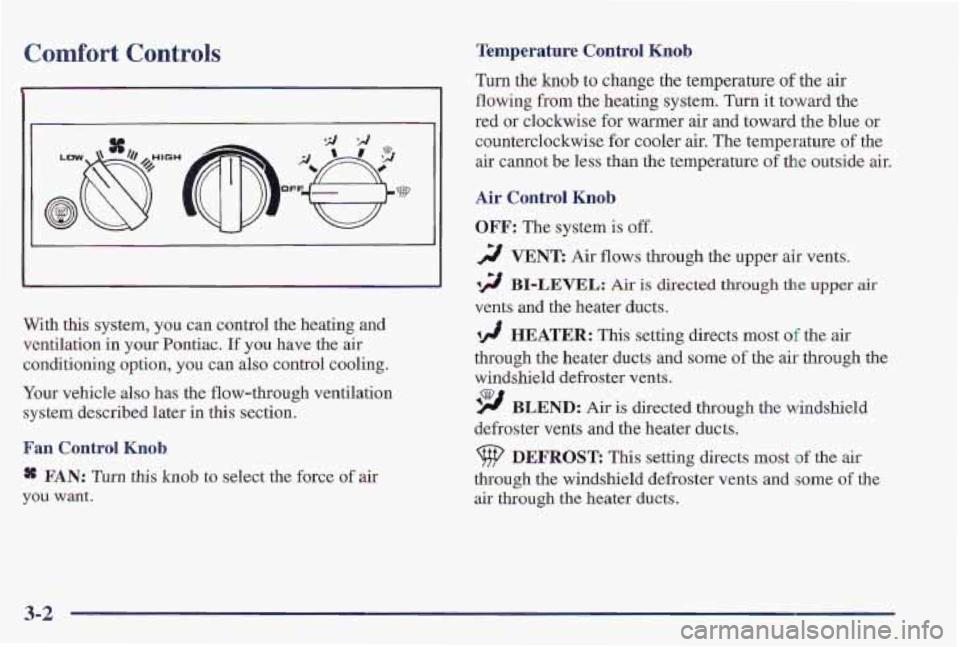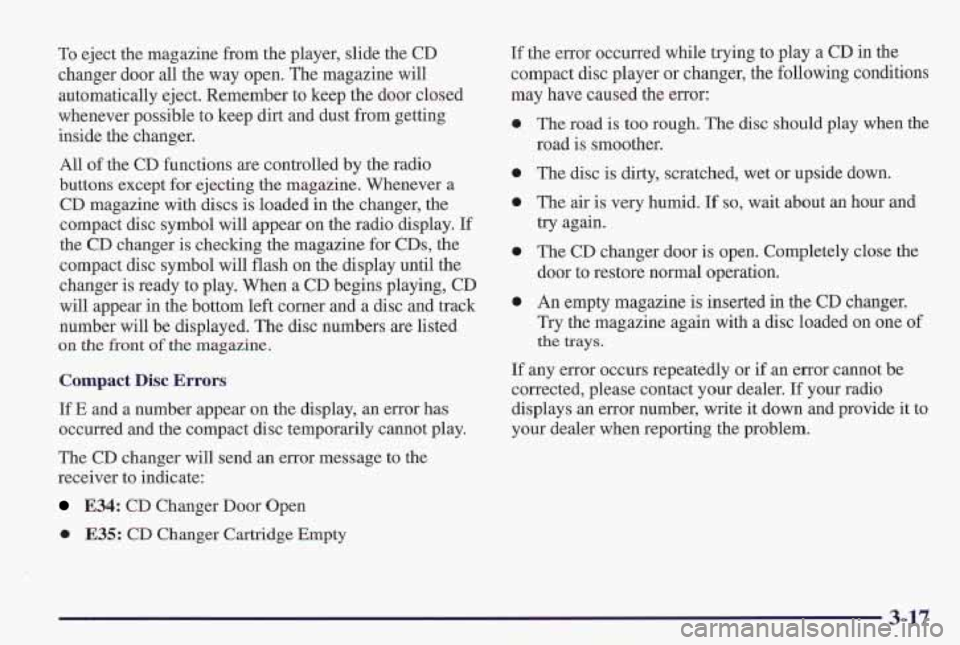air condition PONTIAC FIREBIRD 1997 Owners Manual
[x] Cancel search | Manufacturer: PONTIAC, Model Year: 1997, Model line: FIREBIRD, Model: PONTIAC FIREBIRD 1997Pages: 410, PDF Size: 19.2 MB
Page 128 of 410

Voltmeter
You can read battery
voltage on your voltmeter.
If it reads less than 11 volts
or more than
16 volts while
your engine is running, and
it stays there, you may have
a problem with the
electrical charging system.
Brake System Warning Light
Your Pontiac’s hydraulic brake system is divided into
two parts.
If one part isn’t working, the other part can
still work and stop you.
For good braking, though, you
need both parts working well.
If the warning light comes on, there could be a brake
problem or the brake fluid level could
be low. Have your
brake system inspected right away.
Have it checked right away. Driving with the voltmeter
reading in a warning zone could drain your battery.
If you idle your engine for a while, the voltmeter
reading might move into the yellow zone.
If the reading
stays in the yellow zone while you are driving, you may
have a problem with the electrical charging system.
Have
it checked. While the voltmeter reads in the yellow
zone, your battery may not be able to power certain
electrical accessories, like
ABS. (If this happens, your
ABS INOP light will come on. See “Anti-Lock Brake
System Warning Light” in this part.)
If you must drive a short distance with
the voltmeter
reading in
a warning zone, turn off all your accessories,
including your air conditioning and audio system.
BRAKE
This light should come on
briefly when you turn
the ignition key to
RUN. If
it doesn’t come on then,
have it fixed
so it will be
ready to warn you if there’s
a problem.
If the light comes on while you are driving, pull off the
road and stop carefully.
You may notice that the pedal is
harder to push. Or, the pedal may
go closer to the floor.
It may take longer to stop. If the light is still on, or if the
anti-lock brake system warning light is flashing, have
the vehicle towed for service. (See “Anti-Lock Brake
Page 132 of 410

Engine Coolant Temperature Gage
This gage shows the engine
coolant temperature.
If the
gage pointer moves into the
red area, your engine is too
hot! It means that your
engine coolant has
overheated.
Low Coolant Light (VS Engine)
This warning light should
come on while you are
starting your engine.
If the
light doesn’t
come on, have
it repaired.
If you have been operating your vehicle under normal
driving conditions, you should pull off the road, stop
your vehicle and turn off the engine as soon as possible.
In “Problems
on the Road,” this manual shows what to
do. See “Engine Overheating” in the Index. Your
Firebird is equipped with
a LOW COOLANT
indicator which is designed to detect when the coolant
level drops below set limits. If the low coolant level
sensor (on the radiator) drops while the engine is
running,
the LOW COOLANT indicator will light and
remain lit until the ignition switch
is turned to the OFF
position. Check coolant level and add coolant as needed.
The LOW COOLANT light might stay on after filling
the radiator. Turn the ignition switch to the
OFF
position, then restart the engine to verify that the LOW
COOLANT light goes out. See “Engine Coolant” in
the Index.
2-83
Page 134 of 410

This light should come on, as a check to show you it is
working, when the ignition is on and the engine is not
running. If the light doesn’t come on, have it repaired.
This light will also come on during a malfunction in one
of two ways:
0
0
Light Flashing -- A misfire condition has been
detected. A misfire increases vehicle emissions and
may damage the emission control system on your
vehicle. Dealer or qualified service center diagnosis
and service
is required.
Light On Steady -- An emission control system
malfunction has been detected on your vehicle.
Dealer or qualified service center diagnosis and
service may be required.
If the Light Is Flashing
The following may prevent more serious damage to
your vehicle:
0 Reducing vehicle speed.
0 Avoiding hard accelerations.
0 Avoiding steep uphill grades.
0 If you are towing a trailer, reduce the amount of
cargo being hauled as soon as it is possible.
If the light stops flashing and remains on steady, see “If
the Light
Is On Steady” following.
If the light continues to flash, when it is safe to do so,
stop the vehicle. Find a safe place to park your vehicle.
Turn the key off, wait at least 10 seconds and restart the
engine.
If the light remains on steady, see “If the Light
Is On Steady” following. If the light is still flashing,
follow the previous steps, and drive the vehicle to your
dealer or qualified service center for service.
2-85
Page 135 of 410

If the Light Is On Steady Have you recently changed brands of fuel?
You may be able to correct the emission system
malfunction by considering the following:
Did you recently put fuel into your vehicle?
If
so, reinstall the fuel cap, making sure to fully install
the cap, The diagnostic system can determine if the fuel
cap has been left
off or improperly installed. A loose or
missing fuel cap will allow fuel
to evaporate into the
atmosphere.
A few driving trips with the cap properly
installed should turn the light off.
Did you just drive through
a deep puddle of water?
If so, your electrical system may be wet. The condition
will usually be corrected when the electrical system
dries out. A few driving trips should turn the light
off,
Are you low on fuel?
As your engine starts to run
out of fuel, your engine may
not run as efficiently
as designed since small amounts of
air are sucked into the fuel line causing a misfire. The
system can detect
this. Adding fuel should correct this
condition. Make sure to install
the fuel cap properly. It
will take a few driving trips to turn the light off. If
so, be sure to fuel your
vehicle with quality fuel (see
“Fuel” in the Index). Poor fuel quality will cause your
engine
not to run as efficiently as designed. You may
notice this as stalling after start-up, stalling when you
put the vehicle into gear, misfiring, hesitation on
acceleration or stumbling on acceleration. (These
conditions may
go away once the engine is warmed up.)
This will be detected by the system and cause the light
to turn on.
If you experience one or more
of these conditions,
change the fuel brand
you use. It will require at least one
full tank of the proper fuel to turn the light off.
If none
of the above steps have made the light turn off,
have your dealer or qualified service center check the
vehicle. Your dealer has the proper test equipment
and
diagnostic tools to fix any mechanical or electrical
problems that
may have developed.
2-86
Page 140 of 410

Section 3 Comfort Controls and Audio Systems
In this section, you’ll find out how to operate the comfort control and audio systems offered with your Pontiac.
Be sure to read about the particular systems supplied with your vehicle.
3-2
3-3
3-3
3-4
3-4
3-4
3
-4
3-5
3-5
3-6
3 -6
3-7
Comfort Controls
Air Conditioning
Cooling
Heating
Bi-Level Heating
Ventilation
Defogging and Defrosting
Rear Window Defogger
Ventilation System
Audio Systems Setting the Clock
for All Systems
AM-FM Stereo with Cassette Tape Player
3-10
3- 14
3-16
3-19
3-2
1
3-22
3-22
3-23
3-23
3-24 AM-FM Stereo with Cassette
Tape Player
and Equalizer
AM-FM Stereo with Compact Disc Player
and Equalizer
Trunk Mounted
CD Changer
Theft-Deterrent Feature
Steering Wheel Controls
Understanding Radio Reception
Tips About Your Audio System
Care
of Your Cassette Tape Player
Care
of Your Compact Discs
Power Antenna Mast Care
3-1
Page 141 of 410

Comfort Controls Temperature Control Knob
Turn the knob to change the temperature of the air
I flowing from the heating system, Turn it toward the
I, ,I red or clockwise for warmer air and toward the blue or
counterclockwise
for cooler air. The temperature of the
air cannot be less than the temperature
of the outside air.
Air ContL - - ____ - .b
OFF: The system is off. I
2 VENT Air flows through the upper air vents.
12 BI-LEVEL: Air is directed through the upper air
vents and the heater ducts.
With this
system, you can control the heating and
ventilation in your Pontiac.
If you have the air
conditioning option, you can also control cooling.
Your vehicle also has the flow-through ventilation
system described later in this section.
Fan Control Knob.
a FAN: Turn this knob to select the force of air
you want.
/ HEATER: This setting directs most of the air
through the heater ducts and some
of the air through the
windshield defroster vents.
'9 BLEND: Air is 'directed through the windshield
defroster vents
and the heater ducts.
9 DEFROS'G: This setting directs most of the air
through the windshield defroster vents and some of the
air through the heater ducts.
3-2
Page 142 of 410

Air Conditioning (If Equipped)
I
The air conditioning system uses the same controls as
the heating system, except that the air control knob has
two extra settings, described below.
MAX: Provides maximum cooling or quick cool-down
on very hot days. This setting recirculates most of the air
inside your vehicle.
If it is used for long periods of time,
the air may become dry. This setting directs air through
the upper air vents,
A/C: Use for normal cooling on hot days. This setting
cools outside
air and c‘kts it through the upper air vents.
The i-111- conditioner cumpressor operates in MAX, AIC,
BI-LEVEL, BLEND and DEFROST when the outside
temperature is above freezing. When the
air conditioner
is on,
you may sometimes notice slight changes in
your vehicle’s engine speed and power. This is normal
because the system is designed to cycle the compressor
on and
off to keep the desired cooling and help
fuel economy.
Cooling
The air conditioner works best if you keep your
windows closed. On very
hot days, open the windows
just long enough for the hot air to escape.
1. Turn the air control knob to A/C for normal cooling.
For faster cooling, move the
knob to MAX.
2. Turn the temperature control knob to a
comfortable setting.
3. Move the fan control knob to the desired speed.
Page 156 of 410

To eject the magazine from the player, slide the CD
changer door all the way open. The magazine will
automatically eject. Remember to keep the door closed
whenever possible to keep dirt and dust from getting
inside the changer.
All
of the CD functions are controlled by the radio
buttons except for ejecting
the magazine. Whenever a
CD magazine with discs
is loaded in the changer, the
compact disc symbol will appear on the radio display. If
the CD changer is checking the magazine for CDs, the
compact disc symbol will flash
on the display until the
changer is ready to play. When a CD begins playing, CD
will appear in the bottom left corner and
a disc and track
number will be displayed. The disc numbers are listed
on the front of the magazine.
Compact Disc Errors
If E and a number appear on the display, an error has
occurred and the compact disc temporarily cannot play.
The CD changer will send an error message to the
receiver to indicate:
E34: CD Changer Door Open
0 E35: CD Changer Cartridge Empty
If the error occurred while trying to play a CD in the
compact disc player or changer, the following conditions
may have caused the error:
0
0
e
e
0
The road is too rough. The disc should play when the
road is smoother.
The disc is dirty, scratched, wet or upside down.
The air
is very humid. If so, wait about an hour and
try again.
The CD changer door is open. Completely close the
door to restore normal operation.
An empty magazine is inserted in the
CD changer.
Try the magazine again with a disc loaded on one of
the trays.
If any error occurs repeatedly or if an error cannot be
corrected, please contact your dealer.
If your radio
displays an error number, write
it down and provide it to
your dealer when reporting the problem.
3-17
Page 180 of 410

If you do not have traction control, or if the system is
off, then an acceleration skid is also best handled by
easing your foot off the accelerator pedal.
If your vehicle starts to slide, ease your foot off the
accelerator pedal and quickly steer the way you want the
vehicle to go. If you start steering quickly enough, your
vehicle may straighten out. Always be ready for a
second skid
if it occurs.
Of course, traction is reduced when water, snow, ice,
gravel or other material is on the road. For safety, you’ll
want to slow down and adjust your driving to these
conditions. It
is important to slow down on slippery
surfaces because stopping distance will be longer and
vehicle control more limited.
While driving on a surface with reduced traction, try
your best to avoid sudden steering, acceleration
or
braking (including engine braking by shifting to a
lower gear). Any sudden changes could cause the tires
to slide.
You may not realize the surface is slippery until
your vehicle is skidding. Learn to recognize warning
clues
-- such as enough water, ice or packed snow on
the road to make a “mirrored surface” -- and slow down
when you have any doubt.
Remember: Any anti-lock brake system
(ABS) helps
avoid only the braking skid.
Driving at Night
I
.A
Night driving is more dangerous than day driving.
One reason is that some drivers are likely
to be
impaired -- by alcohol or drugs, with night vision
problems, or by fatigue.
4-15
Page 220 of 410

If No Steam Is Coming From Your Engine
If you get the overheat warning but see or hear no
steam, the problem may not be too serious. Sometimes
the engine can get a little too hot when you:
Climb a long hill on a hot day.
Stop after high-speed driving.
Idle for long periods in traffic.
Tow a trailer.
If you get the overheat warning with no sign of steam,
try this for a minute or
so:
1. If you have an air conditioner, turn it off.
2. Turn on your heater to full hot at the highest fan
speed and open the window as necessary.
3. If you’re in a traffic jam, shift to NEUTRAL (N);
otherwise, shift to the highest gear while
driving
-- AUTOMATIC OVERDRIVE (@) or
DRIVE (D) for automatic transmissions.
If you no longer have the overheat warning, you can
drive. Just to be safe, drive slower for about
10 minutes.
If the warning doesn’t come back on, you can
drive normally.
If the warning continues, pull over, stop, and park your
vehicle right away.
If there’s still no sign of steam, you can idle the engine
for two or three minutes while you’re parked, to see if
the warning stops. But then, if
you still have the
warning,
turn ofSthe engine and get everyone out of the
vehicle until it cools down.
You may decide not to lift the hood but to get service
help right away.
When you decide it’s safe to lift the hood, here’s what
you’ll see: